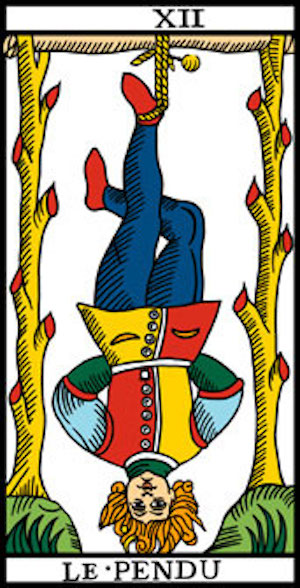Contact Us
We’d love to hear from you

What can the image of The Hanged Man in a pack of Tarot cards teach us about spiritual evolution?
What can The Hanged Man, an iconic and graphic depiction emblematic of being in an awkward position, teach us about losing and finding oneself?
Why does this matter?
If you’ve ever looked at these ancient cards, this one stands out as stranger than all the rest. Around 1500 CE when the Tarot first made its appearance on the European scene, hangings were the preferred method of execution. Macabre messages whose meaning resonated when it was first created in a very direct and personal way. Today, the awkwardness of his position is less jarring, more curious and intriguing than relieving or disorienting, as it would have been in the 16th century. Yet it speaks to us still in profound ways about one of the most central processes of the soul’s journey, the path of ascent.
Let’s take a look at The Hanged Man. He dangles head down very much at ease, very elegantly and confidently crossing his legs. There is no fear in The Hanged Man – his crossed leg forms the shape of a “4” – the sign of Jupiter, the god of good luck and abundance. His eyes are dreamy, his hair stretches like a golden nimbus around his head. He hides his hands, as if to say: Nothing needs to be done, I need no more, I can do no more. Suspended below the transom between two pollarded trees, in all his bright colors, his feet heavenward and his head earthward, he seems to embody acceptance of a new way of being – what was up is down, what was lost is found. Ten buttons punctuate the front of his chest, reminding us of the ten sephirot of the Tree of Life.
Is hanging upside down over the emptiness a vital maneuver for transformation to occur? Is losing our usual perspective needed to ascend? Is plunging like The Hanged Man into the unknown – the empty space around his head – the work required for ascension? Is losing oneself the way to find oneself?
The Hanged Man suggests that answer is YES.
Scholars of Kabbalah have often wondered why mystical ascent was paradoxically called ‘descent’ to describe what practitioners of that art do. In Genesis we read that God hovered over the abyss. Creation arose from that plunge into the darkness – something we do each night as we descend into sleep. It is as if turning our focus into the darkness of our body triggers light and stirs the subconscious chaos into an apparition of order. Think of the subconscious as that great cauldron of millions of bits of experience that coalesce under the piercing eye of the conscious mind. Together the incubating intent of the conscious mind and the magnetized bits of information of the subconscious create light in a form that responds to our questing spirit. Thus, a dream spontaneously arises in answer to the current need of the dreamer.
The Hanged Man illustrates the saying, Let go and let God. Lose everything to find ALL, including one’s self. In its surreal in-your-face depiction, it is urging us to take the mortal leap of trust, a leap that is effortless but terrifying. Like a death, it entails giving up all that we love dearly, all the safeguards we cling to, all our certainties and beliefs, all the goals and demands, and all the ego. It asks us to trust and cleave to a new order that arises from the dream, the vision, the voice. Imagine the Master walking by and saying to you: Get up, and go! Leave everything and follow me!
The Master is the dream, the vision, the voice leading you through the valley of Death – of loss – to transformation. As illustrated by The Hanged Man, losing yourself is the only gateway to finding yourself in inner knowledge and full realization.
Exercise | Drop Your Clothes
Close your eyes. Breathe out slowly three times, counting from 3 to 1. See the “1” tall, clear and bright.
Imagine that you are standing before a very tall and majestic tree whose branches start very close to the ground.
Breathe out. Start climbing the tree. Climb up five branches and drop an article of clothing.
Breathe out. Climb up five more branches and drop another article of clothing.
Breathe out. Climb up five more and again drop an article of clothing.
Breathe out. Continue this way until you are completely naked.
Breathe out. Now drop your first skin.
Breathe out. Climb up five more branches and drop your second skin.
Breathe out. Climb and drop your third skin.
Breathe out. If anything is left of your body continue climbing and dropping (your musculature, your skeleton) until your body is only light.
Breathe out. Climb to the nest at the summit of the tree and sit there, seeing 360 degrees around you.
Breathe out. Stand and catch a multicolored ray of sunlight. Wrap yourself in rainbow light.
Breathe out. Jump down from the summit of the tree to the ground, floating lightly down like a feather and walk away, refreshed and unburdened.
Breathe out. Open your eyes